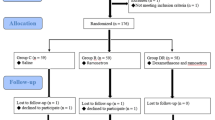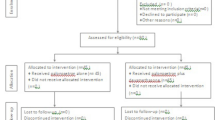Abstract
Introduction
Postoperative Nausea and Vomiting is one of the most common problems after implementation of general anesthesia. The incidence can reach 80% in high-risk patients, depending on the type of surgery. In our study, we aimed to compare dexamethasone–dimenhydrinate and dexamethasone–ondansetron combinations in prevention of nausea and vomiting in postoperative patients.
Method
Sixty 18–65-year-olds ASAI-II females who underwent rhinoplasty were included in the study. Patients were randomly included in two groups: Dexamethasone–dimenhydrinate group (group DD) and dexamethasone–ondansetron group (group DO). All patients received dexamethasone 8 mg iv after endotracheal intubation. Anesthesia continuation was established with sevoflurane, air–oxygen mixture and remifentanil infusion. At the 30th minute of the operation, group DO received ondansetron 4 mg iv and group DD received dimenhydrinate 1 mg/kg iv. For postoperative analgesia tramadol (1.5 mg/kg) iv, tenoksikam (20 mg) and afterward for postoperative patient-controlled tramadol was used. In the postoperative recovery room, nausea and vomiting were evaluated at the 30th, 60th, 120th minutes and at the end of 24 h. Total amount of tramadol was recorded. All results were statistically evaluated.
Observations
Demographics and Apfel risk scores of both groups were similar. Surgical operation duration (p = 0.038) and total preoperative remifentanil consumption were higher in group DD (p = 0.006). In group DO, nausea at 30 and 60 min (p = 0.001, p = 0.007), retching at 30 and 60 min (p = 0.002, p = 0.006) were higher than group DD. The additional antiemetic need in group DO was significantly higher at 30 min (p = 0.001). Postoperative analgesic consumption was similar in both groups.
Result
Our study revealed that dexamethasone–dimenhydrinate combination was more effective than dexamethasone–ondansetron in prevention of nausea and vomiting after rhinoplasty operations.
Level of Evidence IV
This journal requires that authors assign a level of evidence to each article. For a full description of these Evidence-Based Medicine ratings, please refer to the Table of Contents or the online Instructions to Authors www.springer.com/00266.



Similar content being viewed by others
References
Camu F, Lauwers MH (1992) Incidence and etiology of postoperative nausea and vomiting. Eur J Anaesthesiol 9:25–31
Gan TJ et al (2014) Consensus guidelines for the management of postoperative nausea and vomiting. Anesth Analg 118:85–113
Apfel CC, Laara E (1999) A simplified risk skor for predicting postoperative nausea and vomiting. Anesthesiology 91:693–700
Marcus JR, Few JW (2002) The prevention of emesis in plastic surgery: a randomized prospective study. Plast Reconstr Surg 109:2487–2494
Watcha MF, White PF (1992) Postoperative nausea and vomiting: its etiology, treatment and prevention. Anesthesiology 77:162–184
Steely RL, Collins DR, Cohen BE et al (2004) Postoperative nausea and vomiting in the plastic surgery patient. Aesth Plast Surg 28:29–32
Hill RP, Lubarsky DA (2000) Cost-effectiveness of prophylactic antiemetic therapy with ondansetron, droperidol or placebo. Anesthesiology 92:958–967
Lau H, Brooks DC (2001) Predictive factors for unanticipated admissions after ambulatory laparoscopic cholecystectomy. Arch Surg 136:1150–1153
Mehernoor F, Watcha M (2001) Economics of antiemetics in anesthesia. Curr Opin Anaesthesiol 14:563–567
Apfel CC, Kranke P (2002) Volatile anaesthetics may be the main cause of early but not delayed postoperative vomiting: arandomized controlled trial of factorial design. Br J Anaesth 88:659–668
Kothari SN, Boyd WC (2000) Antiemetic efficacy of prophylactic dimenhydrinate(Dramamine) vs ondansetron (Zofran): a randomized, prospective trial in patients undergoing laparoscopic cholecystectomy. Surg Endosc 14:926–929
Kranke P, Morin AM (2002) Dimenhydrinate for prophylaxis of postoperative nausea and vomiting: meta-analysis of randomized controlled trials. Acta Anaesthesiol Scand 46:238–244
Gildasio S, De Oliveira GS (2013) Dexamethasone to prevent postoperative nausea and vomiting: an updated meta-analysis of randomized controlled trials. Anesth Analg 116:58–74
Borison HL (1989) Area postrema: chemoreceptor circumventricular organ of the medulla oblongata. Prog Neurobiol 32:351–390
Gan TJ (2007) Mechanismus underlying postoperative nausea and vomiting and neurotransmitter receptor antagonist-based pharmacotherapy. CNS Drugs 21:813–833
Gan TJ, Meyer TA (2007) Society for Ambulatory Anesthesia guidelines for the management of postoperative nausea and vomiting. Society for ambulatory anesthesia. Anesth Analg 105:1615–1628
Apfel CC, Korttila K (2004) IMPACT investigators. A factorial trial of six interventions for the prevention of postoperative nausea and vomiting. N Engl J Med 350:2441–2451
Arslan M, Demir ME (2011) Prevention of postoperative nausea and vomiting with a small dose of propofol combined with dexamethasone 4 mg or dexamethasone 8 mg in patients undergoing middle ear surgery: a prospective randomized duble-blind study. Bratisl Lek Listy 112:332–336
Sistla S, Rajesh R (2009) Does single-dose preoperative dexamethasone minimize stress response and improve recovery after laparoscopic cholecystectomy. Surg Laparosc Endosc Percutan Tech 19:506–510
Fujii Y, Itakura M (2009) Reduction of postoperative nausea, vomiting and analgesic requirement with dexamethasone for patients undergoing laparoscopic cholecystectomy. Surg Endosc 24:692–696
Tolver MA, Strandfelt P (2012) Randomized clinical trial of dexamethasone versus placebo in laparoscopic inguinal hernia repair. Br J Surg 99:1374–1380
Murphy GS, Szokol JW (2011) Preoperative dexamethasone enhances quality of recovery after laparoscopic cholecystectomy: effect on in-hospital and postdischarge recovery outcomes. Anesthesiology 114:882–890
Youssef TA, Elibiary H (2013) Role of steroids in reducing postoperative edema in rhinoplasty: a meta-analytic study. Eur Arch Otorhinolaryngol 270:1189–1193
Tramer MR, Reynols DJ (1997) Efficacy dose-response, and safety of ondansetron in prevention of postoperative nausea and vomiting: a quantitative systematic review of randomized placebo-controlled trials. Anesthesiology 87:1277–1289
Barbosa MVJ, Nahas FX et al (2004) Ondansetron for the prevention of postoperative nausea and vomiting: which is the best dosage for aesthetic plastic surgery? Aesth Plast Surg 28:33–36
Henzi I, Walder B (2000) Dexamethasone for the prevention of postoperative nausea and vomiting. a quantitative systematic review. Anesth Analg 90:186–194
Caroll NV, Miederhoff PA (1994) Costs incurred by outpatient surgical centers in managing postoperative nausea and vomiting. J Clin Anesth 6:364–369
Dexter F, Tinker JH (1995) Analysis of strategies to decrease postanesthesia care unit costs. Anesthesiology 82:94–101
Zarate E, Watcha MF (2000) A Comparison of the costs and efficacy of ondansetron versus dolasetron for antiemetic prophylaxis. Anesth Analg 90:1352–1358
Watcha MF, Smith I (1994) Cost-effectiveness analysis of antiemetic therapy for ambulatory surgery. J Clin Anesth 6:370–377
Author information
Authors and Affiliations
Corresponding author
Ethics declarations
Conflict of interest
The authors declare that they have no conflicts of interest to disclose.
Rights and permissions
About this article
Cite this article
Kizilcik, N., Bilgen, S., Menda, F. et al. Comparison of Dexamethasone–Dimenhydrinate and Dexamethasone–Ondansetron in Prevention of Nausea and Vomiting in Postoperative Patients. Aesth Plast Surg 41, 204–210 (2017). https://doi.org/10.1007/s00266-016-0772-0
Received:
Accepted:
Published:
Issue Date:
DOI: https://doi.org/10.1007/s00266-016-0772-0




